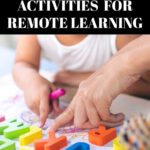Have you been asked to conduct phonics activities for remote learning? Phonics, that is associating the letters with the sounds we hear in our language, adds another layer to learning about phonemic awareness. As an intervention, working on phonics will begin in first grade, with basics such as hearing the first and last sound, and continue through the third grade for some students with more complex letter combinations.

I like to use shared reading for teaching phonics because the students can now see the text. This means having big books and posters of poems and short texts of many kinds for teaching. Texts can also be shared on a document camera or by sharing your screen in an online environment using digital books. I wrote THIS article about digital books. The key is that students need to be able to see the text. Unless a video allows the children to see the text, you do not want to rely on videos of the teacher reading a story. As with using books to teach any skill or strategy it is important the share the text first for enjoyment or learning new content information. Then I can go back and teach the phonic element that I want children to be able to use in text independently.

Some of my favorite tools for teaching phonics are magnetic letters or letter
cards, highlighter tape, and masking cards. I also find My Alphabet posters very useful for both teaching, guided practice and independent practice. Depending on the element of phonics you are teaching it is important to keep in mind that a phonics element that is valuable to teach ought to occur regularly in words.
The Reading Teacher’s Book of Lists by Kress and Fry comes in handy here because you can look up the phonic element and see a list of words that model that element and decide if it is relevant for your students. If it is a very basic element like short a it will be easy to find books with plenty of examples so you can almost pick any book to share but I might want to be sure by choosing a story like The Ant and The Grasshopper by Bill Peet. Right away I can locate words like ant, and, grass, grab, snag, land, stranded are all in the first few pages of the story. You can mark the words with highlighter tape to look at more carefully, build them with magnetic letters, put them on cards to sort out from other words with a, and so on to teach and then practice the sound. The children could look for short “a” words in any book they have, write them on small, single pieces paper and then bring them to the group the next day for the other children to sort with your guidance if needed.
SUGGESTED SHOPPING LIST
PIN ME!!




[…] reading instruction, is what OUR students come to think is important about reading whether it is phonics, learning sight words, answering questions about stories, word meaning, fluency, etc. This is true […]